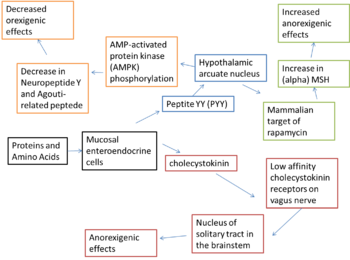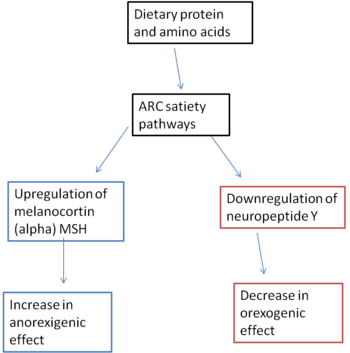Aminostatic hypothesis
For the course duration, the article is closed to outside editing. Of course you can always leave comments on the discussion page. The anticipated date of course completion is 01 April 2012. One month after that date at the latest, this notice shall be removed. Besides, many other Citizendium articles welcome your collaboration! |
In 1956, Mellinkoff proposed the aminostatic hypothesis, stimulated by the observation that when normal individuals ingest protein, appetite diminishes as the serum amino acid concentration rises and vice versa.[1] He believed this was due to a satiety centre in the brain, sensitive to serum amino acids levels, that caused a suppression of hunger once the serum levels reached a certain point.
Experimental Evidence
-experimental evidence has agreed with the aminostatic hypothesis -they have found that high protein diets act on satiety and thermogenesis
Science behind the theory
Experimental evidence agrees with the aminostatic hypothesis that increased amino acid levels in the serum cause a decrease in food intake. Neural pathways which cause an increase in anorexigenic effects and a decrease in orexigenic effects after protein is ingested can explain the satiety found in patients during studies involving high protein diets.
Amino acids obtained from the diet generate post-prandial signals which affect food intake as well as gastric motility and pancreatic secretion. These signals activate specific brain areas in one of two ways:
1) Indirectly though vagus-mediated pathways
2) Directly after their release into the peripheral blood
(The indirect and direct pathways are summarised in the figures.)
In indirect signalling pathways the dietary protein and amino acids present in the small intestine act on chemoreceptors on the mucosal enteroendocrine cells to cause the release of several hormones. Cholecystokinin acts on low affinity receptors on the vagus nerve which project to the nucleus of the solitary tract in the caudal brainstem to give anorexigenic effects. Peptide YY acts in two different ways through targets in the hypothalamic arcuate nucleus. It activates the mammalian target of rapamycin to increase α-MSH which increases anorexigenic effects at the same time as suppressing AMPK phosphorylation to decrease neuropeptide Y and agouti related peptide and cause a decrease in orexigenic effects.
The direct signalling pathway involves the activation of arcuate nucleus satiety pathways by dietary protein and amino acids. This activation causes the upregulation of melanocortin α-MSH to increase anorexigenic effects and a downregulation of neuropeptide Y to decrease orexigenic effects.
Ashleigh Fraser 16:16, 25 October 2011 (UTC)
Use as a method of weight loss
Over the past few years, obesity has become a global epidemic. One third of American adults and approximately 17% of American children are obese (A). In the UK, the statistics are not looking much brighter with 25% of adults and 10% of children showing signs of obesity. It has been proposed in the UK that 60% of men, 50% of women and 25% of children will become obese by 2050 if no preventative measures are taken (B).
This growing prevalence of obesity needs a solution. Many hypotheses regarding various weight loss diets have been proposed, but what about the aminostatic hypothesis which suggests high protein intake? The science behind the theory certainly looks promising. It demonstrates induced levels of thermogenesis and increased satiety, both of which could contribute to weight loss. High Protein diets are becoming increasingly popular all over the world, but are these diets just a fad? Protein intake normally consists of 10-15% from daily calorie allowance. However, a high protein diets consists of obtaining 30-40% of daily calories from protein alone. So, what does a high protein diet consist of and what are the benefits and limitations? Is there any evidence proving the success of this diet?
The Dukan diet is most popular in France, where it was founded by Pierre Dukan. It is based on an allowance of one hundred allowed high protein foods controlled by four phases named attack, cruise, consolidation and stabilisation. This involves a strict regime of initially only eating 72 ‘allowed’ high protein foods (attack phase) for seven days which include beef, chicken and eggs. The next two stages slowly introduce vegetables (cruise phase) and other pleasurable foods (consolidation phase). Finally, other food groups are introduced in the stabilisation phase (F).
The Atkins diet is most popular in America but is slowly gaining recognition in other parts of the world, including the UK. Like the Dukan diet, it also follows a strict regime of ‘allowed’ high protein foods. However, the Atkins diet is strictly no refined carbs (G). Dr Atkins believes many refined carbohydrate foods, such as pasta, also have high sugar levels. Limiting the amount of carbohydrates a person eats would force the body to burn off fat instead of carbs. Restricting refined carbohydrates, and therefore restricting refined sugars, would also diminish the ‘sugar rollercoaster’ that many people experience throughout the day. Thus, the individual would not crave sugary foods and would feel satisfied for longer.
Many clinical trials have been carried out to assess the effects of high protein diets. A meta-analysis of five random clinical trials (N=447) showed that dieters on high protein diets lost more weight, after 6 months, than dieters on the common low fat diets. The mean difference was -3.3kg. (C). However, the same studies showed no difference in weight loss after 12 months of dieting. This, therefore, suggests that high protein diets are only successful for short term weight loss. Another study, however, compared four different diets consisting of varied quantities of carbohydrate and protein in pre-menopausal obese women (N=311). After 12 months of dieting, women who followed the high protein diet showed greater weight loss (mean = -4.7kg) compared to women subjected to the other diets named Zone (mean= -1.6kg), LEARN (mean=-2.6kg) and Ornish (mean=-2.2kg), respectively (D). Moreover, a study carried out by Westerterp-Plantenga et al (2006) (E) concluded that high protein diets are more successful when intake is ad libitum. This supports the evidence that protein has a satiating effect which makes it less likely for impulsive, random eating.
There are however, with many diets, some safety concerns. With high protein diets, there is major concern over renal failure and bone loss. Although evidence is ambiguous regarding high protein diets damaging the kidneys, high protein diets are best avoided in patients with underlying kidney problems (H). High protein diets also propose a concern over bone health. For example, when meat is eaten, calcium is excreted from the bones to fulfil metabolic requirements. Reduced calcium levels in bones could potentially lead to osteoporosis.
The majority of studies conclude that high protein diets do help to lose weight, particularly in short term. However, high protein foods need to be eaten with limiting carbohydrates and fats to gain the maximum benefits. Although this sounds promising, detrimental potential long term effects such as renal failure and bone loss still need to be addressed.
Conclusion
- Future studies, maybe more into long term effects of diet. Any drugs that may interact with pathways? Lisa Robertson 15:44, 25 October 2011 (UTC)
References
- ↑ Mellinkoff SM et al. (1956) Relationship between serum amino acid concentration and fluctuations in appetite J Appl Physiol 8:535-8 PMID 13295170
(A)Centers for Disease Control and Prevention. (2011). U.S Obesity Trends. Available: http://www.cdc.gov/obesity/data/trends.html. Last accessed 25th Oct 2011.
(B)Department of Health. (2011). Obesity. Available: http://www.dh.gov.uk/en/Publichealth/Obesity/index.htm. Last accessed 25th Oct 2011.


